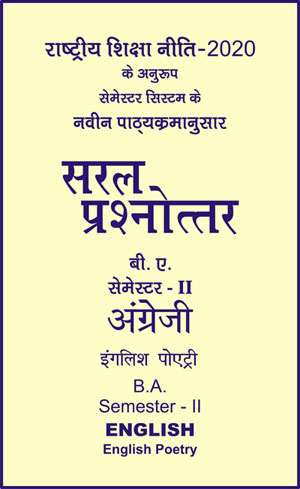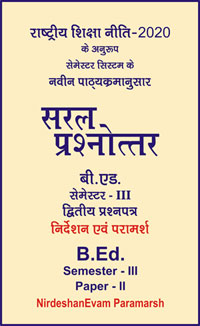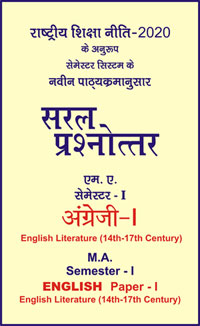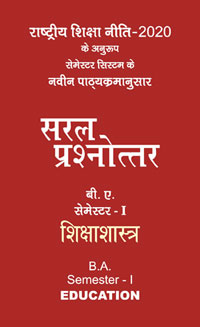|
बी ए - एम ए >> बीए सेमेस्टर-2 - अंग्रेजी - इंगलिश पोएट्री बीए सेमेस्टर-2 - अंग्रेजी - इंगलिश पोएट्रीसरल प्रश्नोत्तर समूह
|
|
|||||||
बीए सेमेस्टर-2 - अंग्रेजी - इंगलिश पोएट्री
Objective Type Questions
For each of the following questions, four alternatives are given for the answer. Only one of them is correct. Choose the correct alternative.
1. What is the date of birth of William Butler Yeats?
(a) April 25, 1867
(b) May 5, 1870
(c) June 13, 1865
(d) March 10, 1875
2. Yeats' parents were
(a) Protestants
(b) Catholics
(c) Jews
(d) None of these
3. The Irish Literary Theatre Society was founded by .........
(a) S.T. Coleridge
(b) W.B. Yeats
(c) Larkin
(d) Auden
4. Yeats fell in love with -
(a) Anne
(b) Elizabeth
(c) Maud Gonne
(d) None of these
5. Which Indian writing touched Yeats?
(a) The Gitanjali
(b) The Ramayan
(c) The Gita
(d) None of these
6. Who helped Yeats in translating the ten principles of upanishads into English?
(a) Tagore
(b) Toru Dutt
(c) Sarojini Naidu
(d) Sri Hamsa
7. In which year, did Yeats win the Nobel Prize for literature.
(a) 1920
(b) 1923
(c) 1925
(d) 1930
8. Yeats died in France in.
(a) 1935
(b) 1937
(c) 1939
(d) 1941
9. Which is the play of Yeats?
(a) The Countess Cathleen
(b) Arms and the Man
(c) Macbeth
(d) Justice
10. Which is not the play of Yeats?
(a) The Winding Stair
(b) The Tower
(c) The Silver Box
(d) Responsibilities
11. Yeats was regarded as the cheif exponent of the ....... movement in England.
(a) reformation
(b) symbolist
(c) Victorian
(d) None of these
12. "The Second Coming' reflects Yeats's most .......... ideas.
(a) emotional
(b) pessimistic
(c) esoteric
(d) revolutionary
13. The theme of "The Second Coming' is the prophecy of the ...........
(a) new civilization
(b) revolution
(c) reformation
(d) None of these
14. The sphinx symbolises the ...... sun-god.
(a) Indian
(b) American
(c) African
(d) Egyptian
15. "The Lake Isle of Innisfree' records of
(a) humanism
(b) escapism
(c) materialism
(d) None of these
16. The poem The Lake Isle of Innisfree' the poet's deep-rooted desire for lovely island ......
(a) Ireland
(b) England
(d) Australia
(c) Innisfree
17. The poet is standing on a ........ in London.
(a) roadway
(b) railway
(c) airway
(d) None of these
18. The poet wishes to build the a ........
(a) shop
(b) road
(c) small cabin
(d) factory
19. The poet will hear the songs of .......
(a) singer
(b) cricket
(c) pop-singer
(d) classical-singer
20. Whose song will he hear in the evening?
(a) Linnets
(b) Cricket
(c) Nightingales
(d) None of these
21. Where did Yeats shift later on?
(a) New York
(b) Sydney
(c) Dublin
(d) None of these
22. How many years did Yeats study art?
(a) One
(b) Two
(c) Three
(d) Four
23. Yeats played a vital role in the politics and literature of...
(a) Finland
(b) Denmark
(c) Venice
(d) Ireland
24. Who Collaborated Yeats in founding the Irish Literary Theatre Society with?
(a) Ldy Lizarus
(b) Lady Gregary
(c) Lady Macbeth
(d) Lady Macduff
25. What did the Irish Literary Theatre Society make the most important figure?
(a) The Irish Literary Renaissance
(b) The American Literary Renaissance
(c) The Indian Literary Renaissance
(d) None of these
26. What was Maud Gonne?
(a) American
(b) African
(c) Irish
(d) Indian
27. Who was associated with a violent section of the Irish revolutionaries?
(a) Lady Gregary
(b) Maud Gonne
(c) Geargle Hyde Lees
(d) None of these
28. In Which year did Yeats and Geargle Hyde Lees get married?
(a) 1914
(b) 1915
(c) 1916
(d) 1917
29. For which country did Yeats develop love?
(a) India
(b) America
(c) Australia
(d) Africa
30. Which book touched Yeats so deeply?
(a) The Bible
(b) The Gitanjali
(c) The Prelude
(d) All of these
31. Whom did Yeats help to revise many of the lyrics?
(a) Tagore
(b) Milton
(c) Tennyson
(d) All of these
32. In which year was Yeats made a member of the Irish Free State?
(a) 1920
(b) 1921
(c) 1922
(d) 1923
33. "Romantic Ireland is dead and gone." Who said this?
(a) Yeats
(b) Keats
(c) Auden
(d) Duke
34. In which tradition did Yeats begin his career?
(a) Victorian
(b) Romantic
(c) Ancient
(d) Pre-Raphaelite Brotherhood
35. Which phase of the poetry of Yeats was marked by his stream return to his passionate life?
(a) First
(b) Last
(c) Middle
(d) None of these
36. Which are the plays of Yeats?
(a) The Countess Cathleen
(b) The Land of Heart's Desire
(c) The Winding Stair
(d) Only 'a' and 'b'
37: In which year was the play "The Countess Cathleen' published?
(a) 1891
(b) 1892
(c) 1893
(d) 1894
38. When was "The Land of Heart's Desire' published?
(a) 1896
(b) 1897
(c) 1898
(d) 1899
39. When was "The Lake Isle of Innisfree' published?
(a) 1895
(b) 1896
(d) 1898
(c) 1897
40. In his early works Keats's 'symbolism' was quite simple ....... and elementary.
(a) conventional
(b) traditional
(c) emotional
(d) None of these
41. What does "The Lake Isle of Innisfree' symbolise?
(a) Palace
(b) Home
(c) School
(d) Utopia
42. What are fully and firmly grounded in Irish mythology and legend?
(a) Keats's symbolism
(b) Keats's theme
(c) Keats's story
(d) None of these
43. Keats's symbols are not ........
(a) clear
(b) vague
(c) out of sense
(d) All of these
44. As Keats's art grew to maturity, his symbols became more and more ........ and.....
(a) simple, personal
(b) vague, graceful
(c) complex, personal
(d) None of these
45. Which helped Keats to express the richness of man's deeper reality?
(a) Nature
(b) Imagery
(c) Thoughts
(d) Symbolism
46. Yeats was a ......... from the beginning to the end of his career.
(a) sonneteer
(b) symbolist
(c) lyricist
(d) None of these
47. Who was regarded as the chief exponent of the symbolist movement in England?
(a) Shakespeare
(b) Milton
(c) Yeats
(d) Chaucer
48. Which phase do The Swan, The Tower, The Winding Stair, The Gyres etc., symbols belongs to?
(a) Later
(b) Middle
(c) Earlier
(d) None of these
49. Yeats's poetry is rich in ........
(a) intellect
(b) emotion
(c) sentiment
(d) images
50. The Second Coming' reflect Yeats' most .........ideas.
(a) constructive
(b) destructive
(c) esoteric
(d) None of these
51. Which poem of Yeats is an attempt at harmonising concrete images with dream like images.
(a) The Lake Isle of Innisfree
(b) The Tower
(c) The Second Coming
(d) None of these
52. Who inspires Yeats to think about an ideal island in the poem "The Lake Isle of Innisfree'?
(a) Lucy
(b) A friend
(c) A Picture
(d) A fountain
53. What picture does the poem "The Second Coming' show about Ireland?
(a) World War
(b) Civilization
(c) Civil War
(d) None of these
54. The poem 'The Second Coming' conveys the terror of coming .......... civilization.
(a) antithetical
(b) ancient
(c) modern
(d) All of these
55. In the poem The Second Coming', the image gradually draws towards ........
(a) Egypt
(b) Africa
(c) England
(d) Bethlehem
56. In the poem 'The Second Coming', the image gradually draws towards Bethehem which is the holy place of ...... worship.
(a) Muslim
(b) Jew
(c) Hindu
(d) Christian
57. Why does the image gradually draw towards Bethlehem in the poem "The Second Coming?
(a) To fight
(b) To be born
(c) To get money
(d) None of these
58. From where does the image come out of in the poem The second coming?
(a) Spiritusmundi
(b) Bethlehem
(c) Jerusalam
(d) None of these
59. How does the image look?
(a) Human
(b) Beast
(c) Half human and half beast
(d) None of these
60. Bethlehem is the birth place of
(a) Lord Rama
(b) Christ
(c) Lord Ayyappa
(d) All of these
61. What type of look has the image?
(a) Emotional
(b) Lovable
(c) Cute
(d) Blank
62. The birth of the image is the ...... of present civilization.
(a) Birth
(b) Re-birth
(c) Death
(d) None of these
63. According to Yeats Modern civilization is full of.........
(a) Violence
(b) Love
(c) Honesty
(d) Care
64. What is required to end the present violent civilization?
(a) An honest leader
(b) A violent God
(c) A brave warrior
(d) A true priest
65. What is the sound of the rocking of the craddle is indicating in the poem "The Second Coming'?
(a) The birth of a baby
(b) Meeting of lovers
(c) The birth of new God
(d) None of these
66. The theme of the poem "The Second Coming' is the ........ of the new civilization.
(a) change
(b) prophecy
(c) transformation
(d) All of these
67. The birds fly when they see .......
(a) The monstrous shape
(b) The hunter
(c) The Lion
(d) The Fox
68. In the poem The Second Coming', the gyre symbolizes the cycle of .........
(a) Geography
(b) Science
(c) History
(d) None of these
69. In the poem, the Falcon means man's .......
(a) emotion
(b) intellect
(c) sentiment
(d) feeling
70. "The Lake Isle of Innisfree' is .......
(a) sonnet
(b) ode
(c) ballad
(d) lyric
71. What was Yeats's first proper Irish poem according to the critics?
(a) The Lake Isle of Innisfree
(b) The Second Coming
(c) The Tower
(d) None of these
72. In which category does "The Lake Isle of Innisfree' belong to?
(a) Love-poem
(b) Dream-poem
(c) Revenge-poem
(d) None of these
73. What inspires Yeats to think about an ideal island?
(a) A friend
(b) A picture
(c) A palace
(d) A fountain
74. Robert Bridges' poetry is:
(a) Satirical
(b) Lyrical
(c) Realistic
(d) Farcial
75. "I hear lake water lappong with low
sound by the shore;"
The line occure in which stanza of the poem "The Lake Isle of Innisfree"?
(a) First
(c) Third
(b) Second
(d) None of these
76. Who wrote "Byzantium"?
(a) John Keats
(b) Wordsworth
(c) W. B. Yeats
(d) S.T. Coleridge
77. W.B. yeats' poetry is remarkable for the use of:
(a) Myth and folklore
(b) Nature and mankind
(c) Green traditions
(d) Criticism of life
78. In the poem of W.B. Yeats, "Innisfree' is :
(a) an island
(b) a sea
(c) a lake
(d) a pond
79. What sort of a house will Yeats build at Innisfree in the poem "The Lake Isle of Innisfree"?
(a) A brick house
(b) A wood house
(c) A sand house
(d) Clay and wood house
|
|||||
- Chapter - 1 Forms of Poetry & Stanza Forms
- Objective Type Questions
- Answers
- Chapter - 2 Poetic Device
- Objective Type Questions
- Answers
- Chapter - 3 "Let Me Not to the Marriage of True Minds" (Sonnet No. 116)
- Objective Type Questions
- Answers
- Chapter - 4 "On His Blindness"
- Objective Type Questions
- Answers
- Chapter - 5 "Present in Absence"
- Objective Type Questions
- Answers
- Chapter - 6 "Essay on Man”
- Objective Type Questions
- Answers
- Chapter - 7 "Elegy Written in a Country Churchyard”
- Objective Type Questions
- Answers
- Chapter - 8 "The World is Too Much with Us"
- Objective Type Questions
- Answers
- Chapter - 9 "Ode on a Grecian Urn"
- Objective Type Questions
- Answers
- Chapter - 10 "Break, Break, Break"
- Objective Type Questions
- Answers
- Chapter - 11 "How Do I Love Thee?"
- Objective Type Questions
- Answers
- Chapter - 12 "Dover Beach"
- Objective Type Questions
- Answers
- Chapter - 13 "My Last Duchess'
- Objective Type Questions
- Answers
- Chapter - 14 "The Love Song of J. Alfred Prufrock"
- Objective Type Questions
- Answers
- Chapter - 15 "The Lake Isle of Innisfree"
- Objective Type Questions
- Answers
- Chapter - 16 "Church Going"
- Objective Type Questions
- Answers
- Chapter - 17 Rhetoric and Prosody - Practical Criticism
- Objective Type Questions
- Answers

 i
i 










